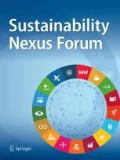

Literatur
Barbier EB (2009) A Global New Deal. Report prepared for the Economics and Trade Branch, Division of Technology, Industry and Economics, UNEP. University of Wyoming, Laramie
Bliesner A, Liedtke C, Welfens MJ, Baedeker C, Hasselkuß M, Rohn H (2014) „Norm-oriented interpretation learning“ and resource use: the concept of „open-didactic exploration“ as a contribution to raising awareness of a responsible resource use. Wuppertal Institut für Klima, Umwelt, Energie GmbH, Wuppertal. doi:10.3390/resources3010001
Bringezu S (2004) Erdlandung. Navigation zu den Ressourcen der Zukunft. Hirzel, Stuttgart
Buchert M, Schüler D, Bleher D (2009) Critical metals for the future sustainable technologies and their recycling potential (Critical metals study for the International Panel for Sustainable Resource Management (Resource Panel)). UNEP, Paris
Bundesministerium für Umwelt, Naturschutz, Bau und Reaktorsicherheit (BMUB) (2012) German Resource Efficiency Programme (ProgRess). Programme for the sustainable use and conservation of natural resources. Decision of the Federal Cabinet on 29 February 2012. http://www.bmub.bund.de/fileadmin/bmu-import/files/pdfs/allgemein/application/pdf/progress_en_bf.pdf. Zugegriffen: 25. Juli 2014
Görlach S, Schmidt M (2010) Maßnahmenvorschläge zur Ressourcenpolitik im Bereich unternehmensnaher Instrumente. Feinanalysepaper für den Bereich Public Efficiency Awareness & Performance. Arbeitspapier zu Arbeitspaket 4 des Projekts „Materialeffizienz und Ressourcenschonung“ (MaRess). Ressourceneffizienzpaper 4.4. Wuppertal Institut für Klima, Umwelt, Energie GmbH, Wuppertal
Jackson T (2009) Prosperity without Growth? Economics for a Finite Planet. Earthscan, London
Kristof K, Hennicke P (2008) Impulsprogramm Ressourceneffizienz: Innovationen und wirtschaftlicher Modernisierung eine Richtung geben: ein Vorschlag des Wuppertal Instituts. Arbeitspapier zu Arbeitspaket 7 des Projekts „Materialeffizienz und Ressourcenschonung“ (MaRess). Ressourceneffizienz Paper 7.2. Wuppertal Institut für Klima, Umwelt, Energie GmbH, Wuppertal
Krueger R, Casey MA (2000) Focus groups: a practical guide for applied research. SAGE Publications, Inc., Thousand Oaks
Lettenmeier M, Rohn H, Liedtke C, Schmidt-Bleek F (2009) Resource productivity in 7 steps. How to develop eco-innovation products and services. Wuppertal Institut für Klima, Umwelt und Energie GmbH, Wuppertal
Lettenmeier M, Liedtke C, Rohn H (2014) Eight tons of material footprint – suggestion for a resource cap for household consumption in Finland. Resources 3(3):488–515
Liedtke C, Busch T (2005) Materialeffizienz – eine Einführung in das Thema. In: Materialeffizienz (Hrsg) Potenziale bewerten, Innovationen fördern, Beschäftigung sichern. oekom, München
Liedtke C, Bienge K, Wiesen K, Teubler J, Greiff K, Lettenemeier M, Rohn M (2013a) Resource use in the production and consumption system – the MIPS approach. In: Resources 2013. Special Issue: how much environment do humans need? + 20 – Reviewing progress in material intensity analysis for transition towards sustainable resource management
Liedtke C, Buhl J, Ameli N (2013b) Designing value through less by integrating sustainability strategies into lifestyles. Int J Sustain Des 2(2):167–180
Meyer B (2008) Wie muss die Wirtschaft umgebaut werden? Perspektiven einer nachhaltigen Entwicklung. Fischer, Frankfurt a. M.
Morgan DL (1997) Focus Groups as Qualitative Research. Qualitative research Methods Series No. 16. 2. Aufl. SAGE Publications, Inc., Thousand Oaks
Ritthoff M, Liedtke C, Kaiser C (2007) Technologien zur Ressourceneffizienzsteigerung: Hot Spots und Ansatzpunkte. Bericht aus dem BMBF-Projekt „Steigerung der Ressourcenproduktivität als Kernstrategie einer nachhaltigen Entwicklung“. Wuppertal Institut für Klima, Umwelt, Energie GmbH, Wuppertal
Rohn H, Lang-Koetz C, Pastewski N, Lettenmeier M (2009) Identifikation von Technologien, Produkten und Strategien mit hohem Ressourceneffizienzpotenzial – Ergebnisse eines kooperativen Auswahlprozesses. Arbeitspapier zu Arbeitspaket 1 des Projekts „Materialeffizienz und Ressourcenschonung“ (MaRess). Ressourceneffizienz Paper 1.2. Wuppertal Institut für Klima, Umwelt, Energie GmbH, Wuppertal
Schmidt-Bleek F (Hrsg) (2004) Der ökologische Rucksack. Wirtschaft für eine Zukunft mit Zukunft. Hirzel, Stuttgart
Schmidt-Bleek F (2007) Nutzen wir die Erde richtig? Die Leistungen der Natur und die Arbeit des Menschen: Von der Notwendigkeit einer neuen industriellen Revolution. Fischer, Frankfurt a. M.
Van der Voet E, van Oers L, Moll S, Schütz H, Bringezu S, de Bryn S, Sevenster M, Warringa G (2005) Policy review on decoupling of economic development and environmental pressure in the EU-25 and AC-3 countries. CML report 166. CML, Leiden. http://ec.europa.eu/environment/natres/pdf/fin_rep_natres.pdf. Zugegriffen: 25. Juli 2014
Author information
Authors and Affiliations
Corresponding author
Rights and permissions
About this article
Cite this article
Baedeker, C., Bowry, J., Rohn, H. et al. Bildung für Ressourcenschonung und -effizienz. uwf 22, 169–175 (2014). https://doi.org/10.1007/s00550-014-0326-3
Published:
Issue Date:
DOI: https://doi.org/10.1007/s00550-014-0326-3

